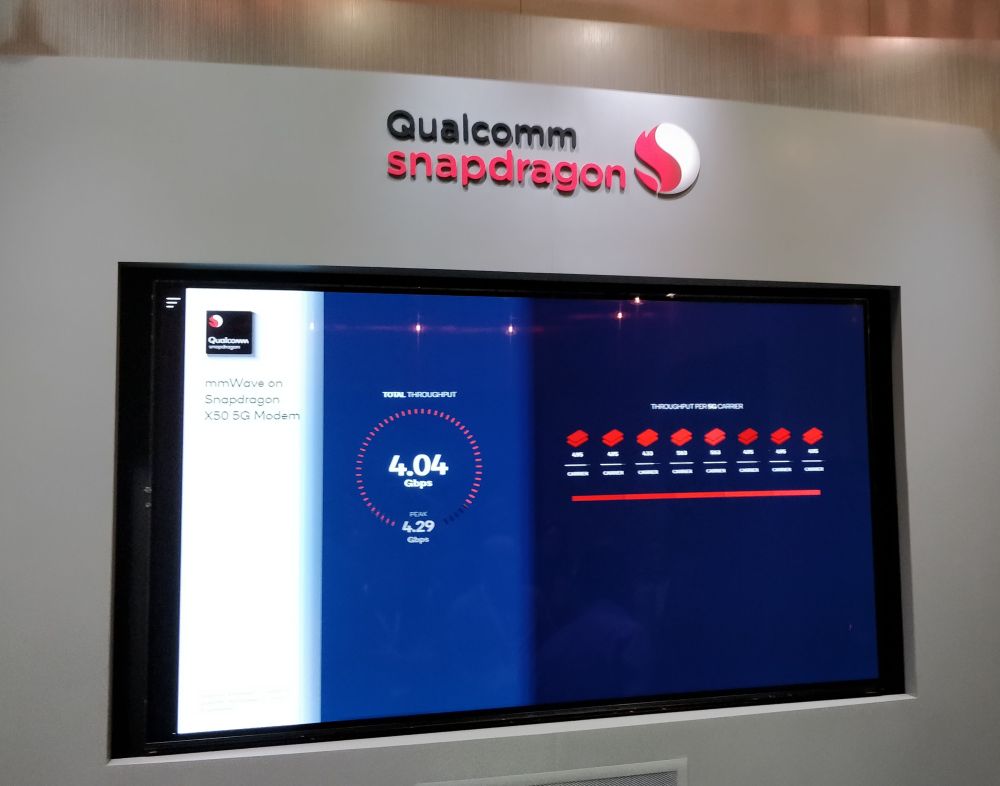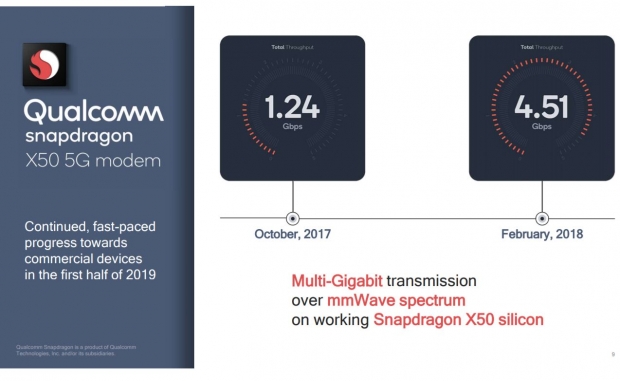Qualcomm will use multi Gigabit transitions together with mmWave spectrum and it managed to demonstrate that live at its headquarters in San Diego, over the air. The fact that Qualcomm showcased 1.24 Gbps speed in October at the company’s 4G – 5G summit in Hong Kong and as soon as four months later it managed to demonstrate the same modem with 4.51 Gbps speed. We saw a live demo reaching up to 4.04 Gbps, which is quite good since the 4.51 Gbps is the best case scenario lab speed today. 
Qualcomm is not alone in the 5G NR revolution. It is important to use 5G NR, as the technology that Intel demonstrated together with KT Telekom is a non 3GPP standard that won't work anywhere outside this Korea Telekom test environment. Intel has yet to showcase its 5G NR silicon.
Bear in mind that the 3GPP standardization body for the whole planet agreed that 5G NR is the one and only way going forward, and this is what Snapdragon X50 supports.
The list of global operators supporting Snapdragon X50 5G Modem for Mobile 5G NR Trials in 2018 includes AT&T, Sprint, Verizon (USA), BT (UK), China Telekom, China mobile, China Unicom – from guess where - China, Deutsche Telekom (Germany), KDDI, NTT Docomo (Japan), Korea Telekom, LG Uplus SK Telekom from Korea, Orange, Vodafone (many countries in Europe), Telecom Italia mobile (TIM) and of course Australia’s jewel Telstra.
These guys will be conducting standard compliant trials based on the Qualcomm X50 5G NR chipset for mobile devices including a smartphone form factor.
The OEMs working on the devices ready for 2019 include Asus, Fujitsu, HMD (Nokia), HTC, inseego, LG, Netcomm, Netgear, Oppo, Sharp, Sierra wireless, Sony, Tellit, Vivo, WNC, Wingtech, Xiaomi and ZTE. Samsung is on board with 5G NR from Qualcomm too as it was made clear crystal to Fudzilla by Cristiano Amon, Qualcomm’s president.
Durga Malladi, senior vice president, engineering, Qualcomm Technologies, Inc, said: “In the same way that our early R&D work on 5G led to the accelerated completion of the first 5G NR standard for enhanced mobile broadband, these demonstrations highlight our continued commitment to inventing technologies that help drive the mobile ecosystem forward. We’re excited to demonstrate these advancements at Mobile World Congress and showcase how our technologies are designed to expand the reach of 5G NR to new industries, new deployment and business models, and new ecosystem participants.”
Qualcomm created a live demonstration of the 5G NR spectrum sharing - a technology that will enable higher levels of mobile broadband performance to unlicensed and shared spectrum, as well as play an important role in extending 5G into new types of deployments such as private networks for industrial IoT.
We had a chance to see the industry-first demonstration of a wireless PROFINET Industrial Ethernet over 5G NR. Private 5G Networks for Industrial IoT are an important area of focus for the next phase of 3GPP 5G NR. There will be factories in the future with machines and robots using 5G instead of ethernet. Putting cables in factories is very expensive and limiting. The demonstration previews new use cases for 5G NR ultra-reliable low latency communication (URLLC) sub-millisecond latency, including the ability to run precise command and control for high demand factory automation applications.
Qualcomm Technologies spent a lot of time highlighting the role of 5G NR-based Cellular Vehicle-to-Everything (C-V2X) technology in autonomous driving. The technology will help vehicles to communicate their intentions, thus supporting the level of predictability needed for advanced path planning. 5G NR based C-V2X will enable much higher data speeds at lower latency that will enable high throughput sensor and intent sharing, and 3D HD map updates.
So 5G NR will enable very fast smartphones and later always connected 5G NR PCs, IoT 4.0 connected 5G industry and many other aspects.




